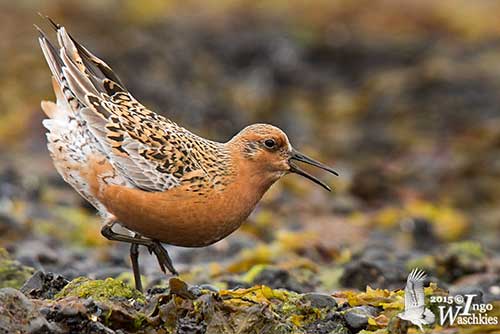
NEW SIBERIAN ISLANDS BIRD SPECIES
Russian archipelago in the Arctic Ocean
New Siberian Islands is the name of an archipelago located in the extreme North of Russia. It extends through the North of the East Siberian coast, between the Laptev Sea and the East Siberian Sea, north of the Sakha Republic. It covers a land area of about 29,000 km², separated from the Siberian mainland by the Dmitri Laptev Strait.
The New Siberian Islands are low-lying, with the highest point on Kotelny Island, the Mt Malakatyn-Tas with 374 metres of elevation.
These islands are often covered by snow and ice, and have very restricted tundra area. They are what remain of the formerly subaerial Great Arctic Plain, lying now below parts of the Arctic Ocean, East Siberian Sea and Laptev Sea.
The New Siberian Islands may gradually disappear. Composed of permafrost alternating with soil, they have been affected by the global warming involving the melting of the ice and the contraction of firm ground.
The archipelago is known as the land of mammoths, and remains are still scattered across these islands. But seeds have also been found, more characteristic of steppe vegetation than Arctic tundra.
The main breeding species is the Red Knot or Knot (Calidris canutus). It breeds on the Arctic tundra, close to the North Pole. The breeding cycle is short, no more than a month or two (June and July), but the juveniles leave the breeding grounds mostly in early August, because frost and snow will cover soon the northernmost parts of the tundra.
Several other bird species also breed in this area, including Black Guillemot, Thick-billed Murre, Long-tailed Duck, Sanderling, Snowy Owl, eiders, gulls and phalaropes.
This inhospitable area is an active breeding location during summer, but then, it sinks into its winter lethargy until the next breeding season, when the birds will return to their nesting sites.
Text by Nicole Bouglouan
Sources:
Wikipedia, the free encyclopaedia
The New Siberian Islands: A disappearing archipelago
In Search of Arctic Birds - Par Richard Vaughan
SORA Searchable Ornithological Research Archive (Blair O. Wolf)
Vegetation and Climate of the New Siberian Islands for the Past 15,000 Years
Bird list:
Arctic Tern - Sterna paradisaea – Sterne arctique
Black Guillemot - Cepphus grylle - Guillemot à miroir
Black-headed Gull – Chroicocephalus ridibundus – Mouette rieuse
Black Kite – Milvus migrans – Milan noir
Black-legged Kittiwake - Rissa tridactyla - Mouette tridactyle
Black-throated Diver (Loon) - Gavia arctica - Plongeon arctique
Boreal Owl - Aegolius funereus - Nyctale de Tengmalm
Brant Goose - Branta bernicla - Bernache cravant
Common Eider - Somateria mollissima - Eider à duvet
Common Goldeneye - Bucephala clangula – Garrot à œil d’or
Common Sandpiper - Actitis hypoleucos - Chevalier guignette
Common Tern - Sterna hirundo - Sterne pierregarin
Curlew Sandpiper - Calidris ferruginea - Bécasseau cocorli
Eurasian Eagle-owl - Bubo bubo - Grand-duc d’Europe
Glaucous Gull - Larus hyperboreus - Goéland bourgmestre
Grey Plover - Pluvialis squatarola - Pluvier argenté
Hen Harrier – Circus cyaneus cyaneus – Busard St Martin
King Eider - Somateria spectabilis - Eider à tête grise
Lapland Longspur - Calcarius lapponicus - Bruant lapon ou Plectrophane lapon
Little Auk or Dovekie - Alle alle - Mergule nain
Little Stint - Calidris minuta - Bécasseau minute
Long-tailed Duck - Clangula hyemalis - Harelde boréale
Merlin - Falco columbarius - Faucon émerillon
Pelagic Cormorant - Phalacrocorax pelagicus - Cormoran pélagique
Peregrine Falcon - Falco peregrinus - Faucon pèlerin
Purple Heron – Ardea purpurea – Héron pourpré
Purple Sandpiper - Calidris maritima - Bécasseau violet
Red Knot - Calidris canutus - Bécasseau maubèche
Red Phalarope - Phalaropus fulicarius - Phalarope à bec large
Red-throated Diver (Loon) - Gavia stellata - Plongeon catmarin
Ruddy Turnstone - Arenaria interpres - Tournepierre à collier
Ruff - Philomachus pugnax - Combattant varié
Sabine’s Gull - Xema sabini - Mouette de Sabine
Short-eared Owl - Asio flammeus - Hibou des marais
Snowy Owl - Bubo scandiacus – Harfang des neiges
Spectacled Eider - Somateria fischeri - Eider à lunettes
Squacco Heron - Ardeola ralloides - Crabier chevelu
Steller’s Eider - Polysticta stelleri - Eider de Steller
Swinhoe’s Snipe - Gallinago megala - Bécassine de Swinhoe
Thick-billed Murre - Uria lomvia - Guillemot de Brünnich
Tufted Duck - Aythya fuligula - Fuligule morillon
White-tailed Sea-Eagle – Haliaeetus albicilla – Pygargue à queue blanche
White Wagtail - Motacilla alba - Bergeronnette grise
Willow Ptarmigan (or Grouse) - Lagopus lagopus - Lagopède des saules
Sources:

Red Knot
Ingo Waschkies
Bird Photography